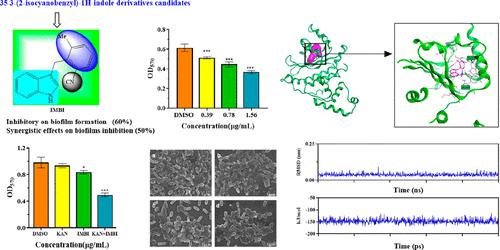当前位置:
X-MOL 学术
›
ACS Infect. Dis.
›
论文详情
Our official English website, www.x-mol.net, welcomes your
feedback! (Note: you will need to create a separate account there.)
Developing 3-(2-Isocyano-6-methylbenzyl)-1H-indole Derivatives to Enhance the Susceptibility of Serratia marcescens by Occluding Quorum Sensing
ACS Infectious Diseases ( IF 4.0 ) Pub Date : 2023-11-16 , DOI: 10.1021/acsinfecdis.3c00433 Jiang Wang 1, 2, 3 , Jing-Yi Yang 1 , Pradeepraj Durairaj 3 , Wei Wang 1 , Shi Tang 1 , Dayong Wang 1 , Chao-Yun Cai 3 , Ai-Qun Jia 2
ACS Infectious Diseases ( IF 4.0 ) Pub Date : 2023-11-16 , DOI: 10.1021/acsinfecdis.3c00433 Jiang Wang 1, 2, 3 , Jing-Yi Yang 1 , Pradeepraj Durairaj 3 , Wei Wang 1 , Shi Tang 1 , Dayong Wang 1 , Chao-Yun Cai 3 , Ai-Qun Jia 2
Affiliation

|
Quorum sensing (QS) inhibition is recognized as a novel antimicrobial target for infections caused by drug-resistant pathogens and is an attractive strategy for antipathogenic agent development. We designed and synthesized three parts of 3-(2-isocyanobenzyl)-1H-indole derivatives and tested their activity as novel quorum sensing inhibitors (QSIs). 3-(2-Isocyanobenzyl)-1H-indole derivatives demonstrated promising QS, biofilms, and prodigiosin inhibitory activities against Serratia marcescens at subminimum inhibitory concentrations (sub-MICs). In particular, 3-(2-isocyano-6-methylbenzyl)-1H-indole (IMBI, 32) was identified as the best candidate based on several screening assays, including biofilm and prodigiosin inhibition. Further studies demonstrated that exposure to IMBI at 1.56 μg/mL to S. marcescens NJ01 significantly inhibited the formation of biofilms by 42%. The IMBI treatment on S. marcescens NJ01 notably enhanced the susceptibility of the formed biofilms, destroying the architecture of the biofilms by up to 40%, as evidenced by scanning electron microscopy (SEM) and confocal laser scanning microscopy (CLSM). For interference of virulence factors in S. marcescens NJ01, IMBI at 3.12 μg/mL inhibited the activity of protease and extracellular polysaccharides (EPS) by 17% and 51%, respectively, which were higher than that of the positive control vanillic acid (VAN). Furthermore, IMBI downregulated the expression of QS- and biofilm-related genes fimA, bsmA, pigP, flhC, rssB, fimC, and rsmA by 1.02- to 2.74-fold. To confirm these findings, molecular docking was performed, which indicated that the binding of IMBI to SmaR, RhlI, RhlR, LasR, and CviR could antagonize the expression of QS-linked traits. In addition, molecular dynamic simulations (MD) and energy calculations indicated that the binding of receptors with IMBI was extremely stable. The biofilms of S. marcescens NJ01 were markedly reduced by 50% when IMBI (0.39 μg/mL) was combined with kanamycin (0.15 μg/mL). In conclusion, this study highlights the potency of IMBI in inhibiting the virulence factors of S. marcescens. IMBI has all the potential to be developed as an effective and efficient QS inhibitor and antibiofilm agent in order to restore or improve antimicrobial drug sensitivity.
中文翻译:

开发 3-(2-异氰基-6-甲基苄基)-1H-吲哚衍生物,通过闭塞群体感应提高粘质沙雷氏菌的敏感性
群体感应 (QS) 抑制被认为是耐药病原体引起的感染的新型抗菌靶点,是抗病原剂开发的一种有吸引力的策略。我们设计并合成了 3-(2-异氰基苄基)-1H-吲哚衍生物的三个部分,并测试了它们作为新型群体感应抑制剂 (QSI) 的活性。3-(2-异氰基苄基)-1H-吲哚衍生物在低于最低抑制浓度 (sub-MICs) 时对粘质沙雷氏菌表现出有希望的 QS、生物膜和神黄素抑制活性。特别是,3-(2-异氰基-6-甲基苄基)-1H-吲哚 (IMBI, 32) 根据多种筛选试验被确定为最佳候选者,包括生物膜和神子菌素抑制。进一步的研究表明,暴露于 1.56 μg/mL 的 IMBI 粘附链球菌 NJ01 可显著抑制生物膜的形成 42%。对粘质链球菌 NJ01 的 IMBI 处理显着增强了形成生物膜的敏感性,破坏了生物膜的结构高达 40%,扫描电子显微镜 (SEM) 和共聚焦激光扫描显微镜 (CLSM) 证明了这一点。对于粘质链球菌 NJ01 毒力因子的干扰,3.12 μg/mL 的 IMBI 对蛋白酶和细胞外多糖 (EPS) 活性的抑制分别提高了 17% 和 51%,高于阳性对照香草酸 (VAN)。此外,IMBI 将 QS-和生物膜相关基因 fimA 、 bsmA 、 pigP、 flhC 、 rssB 、 fimC 和 rsmA 的表达下调 1.02 至 2.74 倍。 为了证实这些发现,进行了分子对接,这表明 IMBI 与 SmaR 、 RhlI 、 RhlR 、 LasR 和 CviR 的结合可以拮抗 QS-连锁性状的表达。此外,分子动力学模拟 (MD) 和能量计算表明,受体与 IMBI 的结合非常稳定。当 IMBI (0.39 μg/mL) 与卡那霉素 (0.15 μg/mL) 联合使用时,粘质链球菌 NJ01 的生物膜显著减少 50%。总之,本研究强调了 IMBI 抑制粘质链球菌 毒力因子的效力。IMBI 具有作为有效和高效的 QS 抑制剂和抗生物膜剂开发的所有潜力,以恢复或提高抗菌药物敏感性。
更新日期:2023-11-16
中文翻译:

开发 3-(2-异氰基-6-甲基苄基)-1H-吲哚衍生物,通过闭塞群体感应提高粘质沙雷氏菌的敏感性
群体感应 (QS) 抑制被认为是耐药病原体引起的感染的新型抗菌靶点,是抗病原剂开发的一种有吸引力的策略。我们设计并合成了 3-(2-异氰基苄基)-1H-吲哚衍生物的三个部分,并测试了它们作为新型群体感应抑制剂 (QSI) 的活性。3-(2-异氰基苄基)-1H-吲哚衍生物在低于最低抑制浓度 (sub-MICs) 时对粘质沙雷氏菌表现出有希望的 QS、生物膜和神黄素抑制活性。特别是,3-(2-异氰基-6-甲基苄基)-1H-吲哚 (IMBI, 32) 根据多种筛选试验被确定为最佳候选者,包括生物膜和神子菌素抑制。进一步的研究表明,暴露于 1.56 μg/mL 的 IMBI 粘附链球菌 NJ01 可显著抑制生物膜的形成 42%。对粘质链球菌 NJ01 的 IMBI 处理显着增强了形成生物膜的敏感性,破坏了生物膜的结构高达 40%,扫描电子显微镜 (SEM) 和共聚焦激光扫描显微镜 (CLSM) 证明了这一点。对于粘质链球菌 NJ01 毒力因子的干扰,3.12 μg/mL 的 IMBI 对蛋白酶和细胞外多糖 (EPS) 活性的抑制分别提高了 17% 和 51%,高于阳性对照香草酸 (VAN)。此外,IMBI 将 QS-和生物膜相关基因 fimA 、 bsmA 、 pigP、 flhC 、 rssB 、 fimC 和 rsmA 的表达下调 1.02 至 2.74 倍。 为了证实这些发现,进行了分子对接,这表明 IMBI 与 SmaR 、 RhlI 、 RhlR 、 LasR 和 CviR 的结合可以拮抗 QS-连锁性状的表达。此外,分子动力学模拟 (MD) 和能量计算表明,受体与 IMBI 的结合非常稳定。当 IMBI (0.39 μg/mL) 与卡那霉素 (0.15 μg/mL) 联合使用时,粘质链球菌 NJ01 的生物膜显著减少 50%。总之,本研究强调了 IMBI 抑制粘质链球菌 毒力因子的效力。IMBI 具有作为有效和高效的 QS 抑制剂和抗生物膜剂开发的所有潜力,以恢复或提高抗菌药物敏感性。































 京公网安备 11010802027423号
京公网安备 11010802027423号